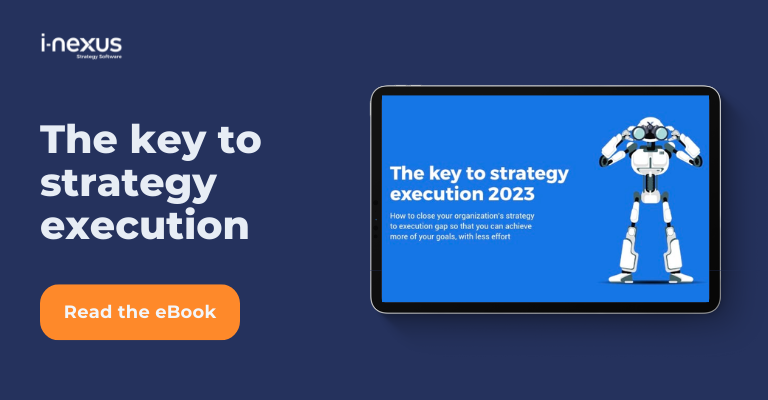As we enter a new decade, organizations need to focus on strategic initiatives and resist—or embrace—disruption. Strategy Execution is the key to turn your vision for the 2020s into reality, and these are the trends your organization must take note of.
Written by: Simon Crowther, CEO
At this time of year, it always seems appropriate to take stock of where we are and look ahead to where we’re going. 2020 marks not only the start of a new year, but a new decade, and a fresh set of trends to be mindful of.
When we’re thinking about our business' strategies, it makes sense to set our horizons further than the next 12 months and consider longer-term themes. So, what can we see, and where are we going?
While the details vary from company to company and industry to industry, the bigger picture is broadly the same. As the Fourth Industrial Revolution drives a relentless onward march in technological development, companies need to embrace digital transformation or face failure.
Red oceans continue to grow
Technological developments tend to have a commoditizing influence.
While a new technology might make it easier for you to deliver a product or service, it can also turn your unique selling point into a common feature that your competitors can easily match.
New technologies also lower the barriers to entry, allowing new players to invade your markets and disrupt the value chain.
As a result, most businesses are now operating in red ocean markets—and there’s only going to be more blood in the water as the 2020s progress.
As competition intensifies, organizations are increasingly focusing on becoming lean, driving operational efficiencies to ensure that they can take advantage of new markets or changing market conditions.
Transformation is the engine to success
Whatever your organization's route to success, transformation is a necessity, and that transformation needs to be managed at a strategic level.
If you are focusing on competing more efficiently so that you can take advantage of changing market conditions, you’ll need strategic initiatives to push through the institutional inertia around existing systems and processes and create buy-in for better ways of working.
If that course leads your organization to create new products or services, for example, you’ll need initiatives that create the momentum the business needs to succeed in new markets.
In both cases, designing the right strategy will only give you a recipe for future success.
The proof of the pudding will be your ability to execute that strategy and deliver real-world change.
In this article, we’ll look at the key trends and provide our predictions for Strategy Execution in 2020 and beyond.
The six Strategy Execution trends of 2020
In summary, Strategy Execution in 2020 will be defined by six themes:
1) Strategy moving beyond the boardroom
2) Real-time insights will power Strategy Execution
3) Improvement initiatives will truly become continuous
4) Project management will draw strength from diversity
5) Businesses will transform to provide Everything-as-a-Service
6) Strategy Execution will be integrated into digital initiatives
Read on to learn why we’ve chosen these six trends to define the year 2020.
1) Strategy will move beyond the boardroom
Strategy has traditionally been a board-level activity, but the next decade will see businesses extending strategic visibility and accountability beyond the boardroom.
Organizations must create a culture where everyone has transparency about:
- What the strategic objectives are
- How those objectives translate into meaningful goals for each team and employee, and
- How the achievement of those goals contributes to the realization of the strategy.
This will be a challenge for both psychological and practical reasons.
The psychological challenges
Senior leaders will need to adapt their mindsets to a more open culture where their decisions are better understood.
Meanwhile, employees will need to accept greater responsibility as their role expands from purely operational concerns to delivering organizational change.
The practical challenges
From a practical perspective, the realities of the modern workplace add to these challenges.
For example, in a world where remote working is a standard expectation, the lines of communication—which are so vital to the execution of any strategy—are stretched further than ever before.
As boards seek to keep closer tabs on the progress of their strategic initiatives, organizations will need to adopt new tools to increase cohesion among cross-functional transformation teams that are fragmented across offices, countries, and even continents.
As a result, we will see greater adoption of Strategy Execution technologies that provide new ways to communicate strategic objectives, cascade goals through the organization, and enable employees to provide instant updates on their progress, anytime, anywhere.
2) Real-time insight will power Strategy Execution
Today, most companies keep track of strategy-relevant information in a host of documents, spreadsheets and project management tools.
They’re capturing the right data in those tools, but it is fragmented across multiple silos.
The result is a black-box approach to strategy deployment: the status of each strategic initiative is opaque and nobody can see the full picture.
And that is even without specifically addressing the other concerns with their use.
Over the coming decade, as the discipline of Strategy Execution Management matures, we will see the focus shift from collecting data to turning it into actionable insight. The plethora of disconnected tools will be replaced by centralized Strategy Execution Management systems that provide a single source of truth for decision-making.
In addition to increasing data quality, this will also make the data much more accessible.
Every function, division and region will use the same digital solutions to capture, view and analyze strategy-relevant insights.
As a result, it will be much easier to create and maintain cross-functional, cross-regional project teams to deploy strategic initiatives consistently across the entire global organization.
Machine assisted Strategy Execution
While automation is becoming commonplace with supporting organization's in streamlining routine tasks or found in driving marketing communications, 2020 will mark the decade where AI and Machine Learning will support your Strategy Execution.
AI will begin to work as a virtual support team: advising, analyzing, flagging risks and predicting performance. The end result is an intelligent system which supports your organization as a strategic partner, researcher and virtual consultant.
3) Improvement initiatives will become truly continuous
In the world of Industry 4.0, change is the only constant—which means that the successful deployment of a strategic initiative is only the starting point.
Organizations cannot afford to pat themselves on the back for a job well done and rest on their laurels. Instead, each initiative needs to act as a self-sustaining engine for Continuous Improvement (CI).
Today, this is rarely the case. The motor of operational excellence only continues running as long as senior leaders are in the driver’s seat; once they’ve moved on to a new project, the well-oiled machine soon sputters to a standstill.
In the high-octane competition of the 2020s, organizations can’t afford to let these initiatives stall. Successful Strategy Execution means putting rigorous governance in place to maintain momentum and seize every opportunity for further improvement.
Achieving success will be influenced by not only the knowledge and application of CI best practice, but also having the right technologies in place.
Once again, technology will need to play a vital role by providing the right monitoring frameworks to keep operational excellence front-of-mind for senior leaders and avoid being derailed when focus switches to new initiatives.
4) Project management will draw strength from diversity
The 2020s will be the decade when the Project Management Office takes its rightful place at the center of the organization.
To this end, it will be critical for leadership teams to recognize the fact that managing strategic initiatives is not just an important add-on to the core business—it is the core business.
As a result, we can expect renewed focus on project management methodologies, with hot debate around the most effective way to structure projects and teams to ensure success.
Structuring and delivering projects
Resources such as stratexhub.com are already becoming increasingly popular as organizations seek to redefine project management within the broader context of Strategy Execution.
It’s unlikely that one size will fit all; each organization will cut its coat according to its cloth, adopting different variants of common project management and Strategy Execution patterns.
The important thing is to choose a technology platform that is flexible enough to support whatever model the organization finds most effective.
Building project management teams
Similarly, organizations will need a flexible approach to building project management teams.
Since each project may involve stakeholders from different regions and functions, with different experience, skills and cultures, an approach that supports diversity and inclusion is critical.
Organizations must make it as easy as possible for everyone on the team to contribute to a project’s success. This means that project management tools must have zero barriers to entry.
Intuitive, mobile-friendly solutions can deliver a lot of value, especially when team members need to fit project-related work around their other day-to-day responsibilities on the shop-floor or out in the field.
5) Businesses will transform to provide Everything-as-a-Service
In the 2020s, customers will expect companies to provide Everything-as-a-Service, which will require a significant transformation of the delivery models for all kinds of products and services.
It’s reasonable to predict that the number of transformation projects per business will double over the next few years. This will be caused by businesses scrambling to redesign their value chains and shift from selling units to a subscription-based, customer-experience-focused business.
The implementation and governance of these business transformation projects will continue to be the biggest obstacles to realizing their success.
Once the target operating model has been defined, organizations will need to place a relentless focus on execution to ensure that their investments in transformation translate to real change.
Putting new systems in place to support Strategy Execution will only become more important as the number and scale of these transformation projects increases.
6) Strategy Execution will be integrated into digital initiatives
The Fourth Industrial Revolution is being driven by a confluence of technologies. For example, the combination of the Internet of Things (IoT) with artificial intelligence and machine learning (AI/ML). This is already opening new blue-ocean markets for all kinds of industries, from autonomous transportation to smarter manufacturing.
An organization’s ability to take advantage of these technologies depends not only on its technical competency, but also its existing domain knowledge. This gives it both the expert insight to identify gaps in the market, and the rich data to train AI/ML models to exploit those gaps.
Successful digital transformation requires bringing together technologists, data scientists and domain experts, while also establishing new technology platforms that streamline the integration of new solutions and reduce the impact of technical debt from legacy systems.
Strategy Execution systems need to be regarded as an integral part of this digital transformation, embedding strategic information and monitoring into every area of the business to ensure that new technologies continue to deliver the expected business value.
For example, the i-nexus Strategy Execution Management solution provides real-time Strategy Execution data for stakeholders at all levels of the organization, from high-level reports for senior leaders to instant, granular feedback for daily contributors—and intermediate dashboards for every level of management in between.
What are the next steps?
With these trends firmly in mind, i-nexus can help you establish an enterprise-class Strategy Execution platform that will help drive a culture of continuous innovation and improvement.
By empowering you to convert strategic visions into far-reaching operational change, our platform will help your business harness disruptive technologies and seize competitive advantage. To learn more, explore our resources below:
- Assessing organizational capabilities: How do I know my goals will be delivered? Explore the importance of an organizational capabilities profile when it comes to executing your strategy.
- How AI and machine-assisted learning will help your Strategy Execution: As Artificial Intelligence becomes a mainstay in our lives, read how AI and machine-assisted learning will evolve to support your Strategy Execution.
- Plotting a course for business transformation: As markets become hyper-competitive, transformation is crucial for success; these are the trends you need to follow in 2020.
About the author
Simon is i-nexus’ CEO. His focus is to bring out the best of the talented i-nexus team as well as improve the quality of our customers’ experiences.
If you’d like to talk more about your strategic challenges connect with Simon on LinkedIn.



